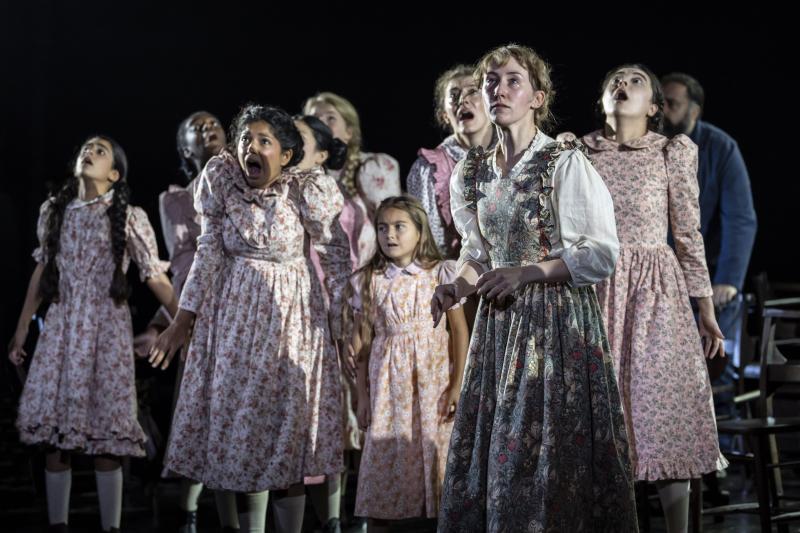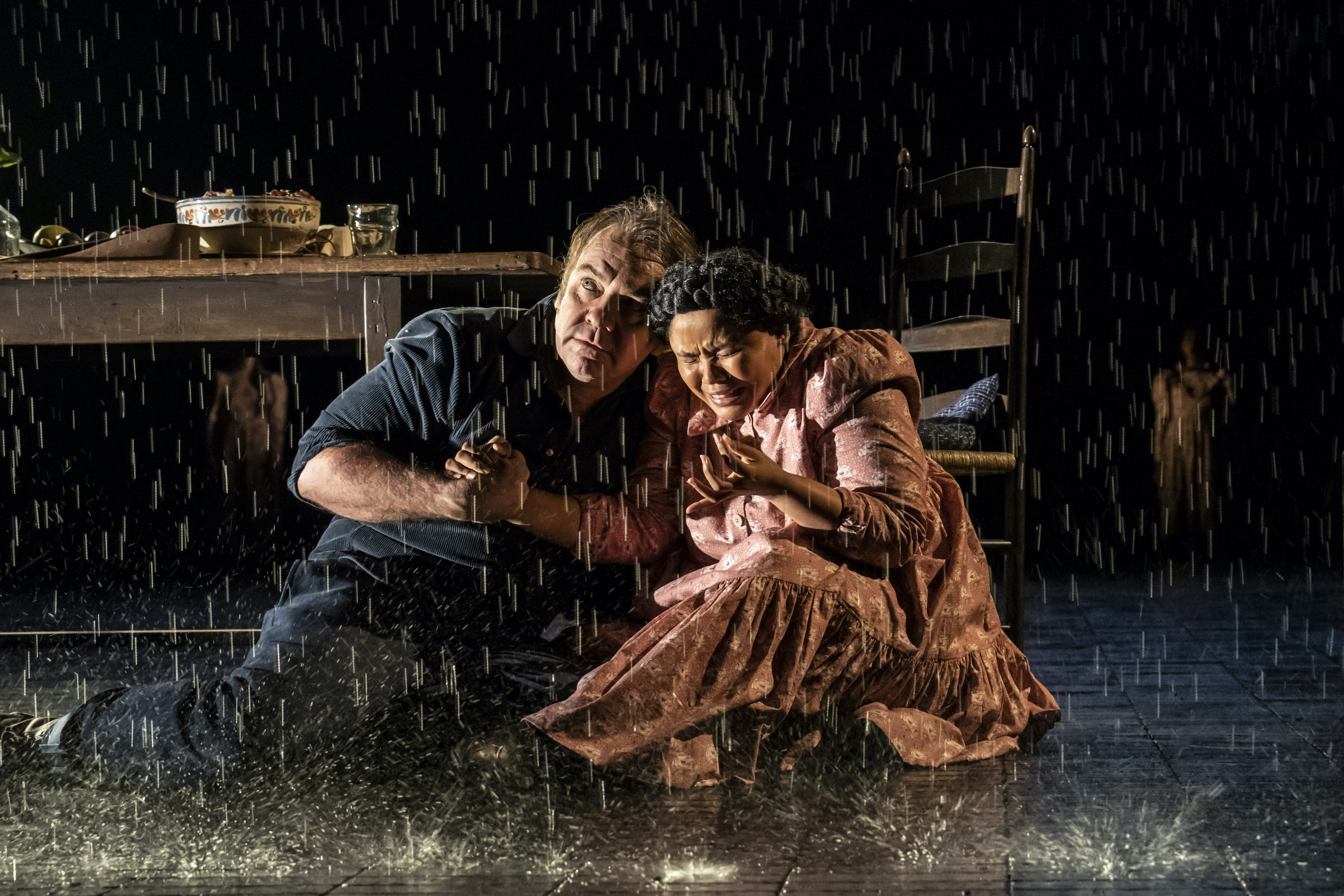The Crucible, National Theatre review - visually stunning revival of Miller's classic drama | reviews, news & interviews
The Crucible, National Theatre review - visually stunning revival of Miller's classic drama
The Crucible, National Theatre review - visually stunning revival of Miller's classic drama
Lyndsey Turner paints this seminal drama with disturbing colours

How can this beauty arise from such ugliness? The Crucible, Arthur Miller’s 1953 drama about the Salem witch trials of 1692, is rife with unwavering prejudices, selfish slander, and sickening motives.
Nearly 70 years after on, The Crucible remains an object lesson in the perils of groupthink and mass hysteria, its tragedy buttressed by merciless intersections of the personal and the political. When the 17-year-old Abigail Williams (a darkly blushing Erin Doherty) incites a group of young girls in Salem to accuse their neighbours of witchcraft, the whole town finds itself sucked into a vortex of unfounded indictments and imminent executions. As John Proctor (Brendan Cowell – Abigail’s one-time lover – strives to extricate himself and his wife from the machinations closing in around them, trials without lawyers and testimonies without evidence paint them into a corner.
But such “painting” is also done by Turner herself, who marshals an impressive array of stage compositions – ranging from the warmly domestic to the blood-chillinglya austere – to animate the play’s hell-bound trajectory. Es Devlin’s deceptively simple set, dominated by a ceiling-like, rain-spouting platform, utilises the depth of the Olivier to marvellous effect: while much of the action unfolds downstage centre, the upper reaches occasionally host haunting enactments of otherwise narrated material. Tim Lutkin’s intricate lighting is indispensable to the emotional texture, as is Tingying Dong and Paul Arditti’s sound design, which underscores the mounting tension.
 An assured cast of over 25 navigates the play’s thorny woods with great ease. Doherty’s Abigail is legibly unhinged from the get-go; whenever put under pressure, she remains quick to seize the upper hand. Her frenzied, breathless asperity hints at a young woman whose destructive impulse is bound to turn inward too. As Proctor, a plodding (at the start) Cowell (pictured above with Rachelle Diedericks as Mary Warren) organically shifts gears as his character comes under greater attack. By the end, it is genuinely distressing to see the shell of himself that he has become.
An assured cast of over 25 navigates the play’s thorny woods with great ease. Doherty’s Abigail is legibly unhinged from the get-go; whenever put under pressure, she remains quick to seize the upper hand. Her frenzied, breathless asperity hints at a young woman whose destructive impulse is bound to turn inward too. As Proctor, a plodding (at the start) Cowell (pictured above with Rachelle Diedericks as Mary Warren) organically shifts gears as his character comes under greater attack. By the end, it is genuinely distressing to see the shell of himself that he has become.
Among the supporting performances, Fisayo Akinade is admirably articulate as Reverend Hale, whose increasing doubts about the legal proceedings are deftly conveyed. Diedericks is excellent as the complicit Mary who ends up coming clean, even as she continues to experience crippling doubt. John Proctor’s wife Elizabeth comes fiercely alive in Eileen Walsh’s nimbly modulated performance: a single look communicates a thrilling mixture of conflicting feelings. Matthew Marsh’s Deputy Governor Danforth and Karl Johnson’s Giles Corey further impress, as well.
Turner’s production sets great store by its exceptional ability to capture – and nurture – moments of remarkable tension, so much so that, at times, the physicality of the life on stage seems to come to a standstill, as if arrested by the concurrent interplay of looks, gestures, and words. On occasion, this emphasis on the particulars gives way to a faltering of the overall tempo, which is perhaps exacerbated by the play’s own verbosity and its slightly drawn-out length. Likewise, Turner’s decision to frame her staging with passages from Miller’s prologue and epilogue – delivered by the ensemble of girls, all clad in doll-like pinks – feels at odds with the enclosed intimacy elsewhere.
Even if this American classic doesn't here receive a particularly daring or novel interpretation, there is no denying its enduring relevance and power. In serving Miller’s text with discipline and care, Turner's staging is both sturdy and elegant, allowing contrary impulses to clash with shattering results.
rating
Explore topics
Share this article
The future of Arts Journalism
You can stop theartsdesk.com closing!
We urgently need financing to survive. Our fundraising drive has thus far raised £49,000 but we need to reach £100,000 or we will be forced to close. Please contribute here: https://gofund.me/c3f6033d
And if you can forward this information to anyone who might assist, we’d be grateful.

Subscribe to theartsdesk.com
Thank you for continuing to read our work on theartsdesk.com. For unlimited access to every article in its entirety, including our archive of more than 15,000 pieces, we're asking for £5 per month or £40 per year. We feel it's a very good deal, and hope you do too.
To take a subscription now simply click here.
And if you're looking for that extra gift for a friend or family member, why not treat them to a theartsdesk.com gift subscription?
more Theatre
 Troilus and Cressida, Globe Theatre review - a 'problem play' with added problems
Raucous and carnivalesque, but also ugly and incomprehensible
Troilus and Cressida, Globe Theatre review - a 'problem play' with added problems
Raucous and carnivalesque, but also ugly and incomprehensible
 Clarkston, Trafalgar Theatre review - two lads on a road to nowhere
Netflix star, Joe Locke, is the selling point of a production that needs one
Clarkston, Trafalgar Theatre review - two lads on a road to nowhere
Netflix star, Joe Locke, is the selling point of a production that needs one
 Ghost Stories, Peacock Theatre review - spirited staging but short on scares
Impressive spectacle saves an ageing show in an unsuitable venue
Ghost Stories, Peacock Theatre review - spirited staging but short on scares
Impressive spectacle saves an ageing show in an unsuitable venue
 Hamlet, National Theatre review - turning tragedy to comedy is no joke
Hiran Abeyeskera’s childlike prince falls flat in a mixed production
Hamlet, National Theatre review - turning tragedy to comedy is no joke
Hiran Abeyeskera’s childlike prince falls flat in a mixed production
 Rohtko, Barbican review - postmodern meditation on fake and authentic art is less than the sum of its parts
Łukasz Twarkowski's production dazzles without illuminating
Rohtko, Barbican review - postmodern meditation on fake and authentic art is less than the sum of its parts
Łukasz Twarkowski's production dazzles without illuminating
 Lee, Park Theatre review - Lee Krasner looks back on her life as an artist
Informative and interesting, the play's format limits its potential
Lee, Park Theatre review - Lee Krasner looks back on her life as an artist
Informative and interesting, the play's format limits its potential
 Measure for Measure, RSC, Stratford review - 'problem play' has no problem with relevance
Shakespeare, in this adaptation, is at his most perceptive
Measure for Measure, RSC, Stratford review - 'problem play' has no problem with relevance
Shakespeare, in this adaptation, is at his most perceptive
 The Importance of Being Earnest, Noël Coward Theatre review - dazzling and delightful queer fest
West End transfer of National Theatre hit stars Stephen Fry and Olly Alexander
The Importance of Being Earnest, Noël Coward Theatre review - dazzling and delightful queer fest
West End transfer of National Theatre hit stars Stephen Fry and Olly Alexander
 Get Down Tonight, Charing Cross Theatre review - glitz and hits from the 70s
If you love the songs of KC and the Sunshine Band, Please Do Go!
Get Down Tonight, Charing Cross Theatre review - glitz and hits from the 70s
If you love the songs of KC and the Sunshine Band, Please Do Go!
 Punch, Apollo Theatre review - powerful play about the strength of redemption
James Graham's play transfixes the audience at every stage
Punch, Apollo Theatre review - powerful play about the strength of redemption
James Graham's play transfixes the audience at every stage
 The Billionaire Inside Your Head, Hampstead Theatre review - a map of a man with OCD
Will Lord's promising debut burdens a fine cast with too much dialogue
The Billionaire Inside Your Head, Hampstead Theatre review - a map of a man with OCD
Will Lord's promising debut burdens a fine cast with too much dialogue

Add comment